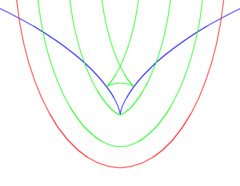- Parallel curve
-
 An ellipse (red), its evolute (blue) and some parallel curves (green). Note how the parallel curves have cusps when they touch the evolute
An ellipse (red), its evolute (blue) and some parallel curves (green). Note how the parallel curves have cusps when they touch the evolute
 Animation of the construction of the parallel curves : ellipse (red), evolute (astroid, blue) and animation of parallel curves in black.
Animation of the construction of the parallel curves : ellipse (red), evolute (astroid, blue) and animation of parallel curves in black.
A parallel of a curve is the envelope of a family of congruent circles centered on the curve. It generalises the concept of parallel lines. It can also be defined as a curve whose points are at a fixed normal distance of a given curve.[1]
It is sometimes called the offset curve but the term "offset" often refers also to translation. The term "offset curve" is used, e.g., in numerically controlled machining (and in other computer graphics applications), where it describes the shape of the cut made by a round cutting piece, which is "offset" from the trajectory of the cutter by a constant distance in the direction normal to the cutter trajectory at every point.
A curve that is a parallel of itself is autoparallel. The involute of a circle is an example.
Contents
Alternative definitions
Alternatively, one can fix a circle and a point on the curve and take the envelope of the translations taking that point to the circle.
Tracing the center of a circle rolled along the curve (see roulette) would give one branch of a parallel.
Parametric curve
For a parametrically defined curve, the following equations define one branch of its parallel curve with distance
 (the other branch is obtained with
(the other branch is obtained with  ):
):Geometric properties
As for parallel lines, a normal line to a curve is also normal to its parallels.
When parallel curves are constructed they will have cusps when the distance from the curve matches the radius of curvature. These are the points where the curve touches the evolute.
If the initial curve is a boundary of a planar set and its parallel curve is without self-intersections, then the latter is the boundary of the Minkowski sum of the planar set and the disk of the given radius.
References
- ^ Willson, Frederick Newton (2009). Theoretical and Practical Graphics. BiblioBazaar, LLC. p. 66. ISBN 1-113-74312-3. http://books.google.com/books?id=QRgwtl1lyzkC., Chapter 5, page 66
External links
Differential transforms of plane curves Parallel curve | Evolute | Involute | Pedal curve | Contrapedal curve | Negative pedal curve | Dual curve | Inverse curve

This geometry-related article is a stub. You can help Wikipedia by expanding it.

![X[x,y]=x+\frac{ay'}{\sqrt {x'^2+y'^2}}](c/14cdea8942e40802daf06026573de1f7.png)
![Y[x,y]=y-\frac{ax'}{\sqrt {x'^2+y'^2}}.](2/d8256c2df2560cc13dc6adf16dfdf44d.png)